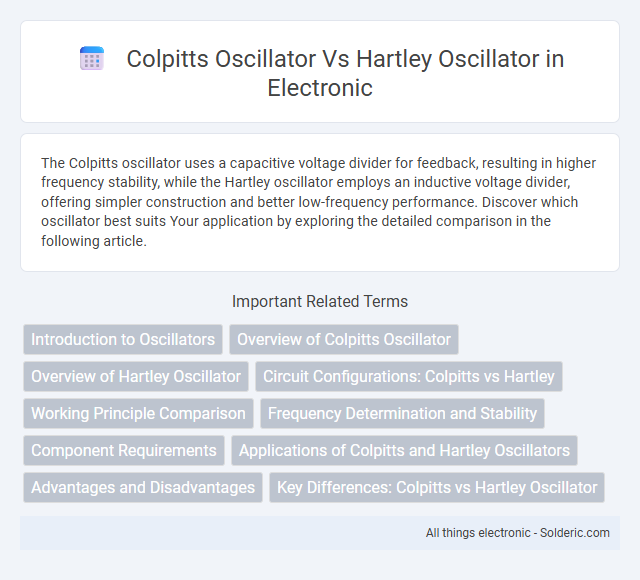The Colpitts oscillator uses a capacitive voltage divider for feedback, resulting in higher frequency stability, while the Hartley oscillator employs an inductive voltage divider, offering simpler construction and better low-frequency performance. Discover which oscillator best suits Your application by exploring the detailed comparison in the following article.
Comparison Table
| Feature | Colpitts Oscillator | Hartley Oscillator |
|---|---|---|
| Oscillator Type | LC Oscillator | LC Oscillator |
| Tank Circuit | Capacitive Divider (Two capacitors in series) | Inductive Divider (Two inductors or tapped coil) |
| Frequency Determination | Based on capacitors and inductor values (f = 1 / 2p(L * C_eq)) | Based on inductors and capacitor values (f = 1 / 2p(L_eq * C)) |
| Feedback Type | Capacitive feedback | Inductive feedback |
| Typical Use Cases | High-frequency stable oscillations, RF circuits | Low to medium frequency, simpler construction |
| Advantages | Better frequency stability, less signal distortion | Simple design, easy tuning |
| Disadvantages | Complex capacitor design, sensitive to capacitor variations | Less frequency stability, coil winding required |
Introduction to Oscillators
Colpitts and Hartley oscillators are fundamental types of LC oscillators used for generating sinusoidal signals in radio frequency applications. The Colpitts oscillator employs a capacitive voltage divider as its feedback network, while the Hartley oscillator uses an inductive voltage divider consisting of tapped coils or separate inductors. Both oscillators rely on resonant LC circuits to determine the oscillation frequency and are widely utilized in communication systems and signal generation.
Overview of Colpitts Oscillator
The Colpitts oscillator is a popular LC oscillator circuit known for generating stable sinusoidal signals using a capacitive voltage divider in its feedback network. It consists of a single transistor or amplifier and two capacitors that define the oscillation frequency along with an inductor, providing better frequency stability compared to the Hartley oscillator. Your designs requiring precise frequency control often benefit from the Colpitts oscillator's reduced phase noise and improved high-frequency performance.
Overview of Hartley Oscillator
The Hartley oscillator is a classic LC oscillator featuring a tapped coil or two inductors in series, which determines its frequency of oscillation. Known for its simplicity and ease of tuning, the Hartley oscillator generates sinusoidal waveforms used in RF circuits, signal generators, and communication systems. Your choice of the Hartley oscillator can provide stable frequency output with minimal component count and straightforward frequency adjustment.
Circuit Configurations: Colpitts vs Hartley
The Colpitts oscillator features a capacitive voltage divider in its feedback network, typically using two capacitors in series connected to the transistor's emitter or source, providing frequency stability and ease of tuning. In contrast, the Hartley oscillator utilizes an inductive voltage divider formed by a tapped coil or two inductors in series, which influences the feedback amplitude and frequency range. Your choice between these circuits depends on the desired component characteristics, frequency stability, and tuning requirements, with the Colpitts favored for higher frequency stability and the Hartley offering simpler inductive tuning options.
Working Principle Comparison
The Colpitts oscillator operates using a capacitive voltage divider as its feedback network, where the oscillation frequency depends on the series combination of capacitors and an inductor. The Hartley oscillator relies on an inductive voltage divider formed by two inductors or a tapped coil to provide feedback, determining its oscillation frequency through the total inductance and a capacitor. Both oscillators produce sinusoidal waveforms by satisfying the Barkhausen criteria but differ in their feedback element selection, impacting frequency stability and circuit design complexity.
Frequency Determination and Stability
The Colpitts oscillator determines frequency using a capacitive voltage divider, offering higher frequency stability due to less sensitivity to component variations, especially in capacitors. The Hartley oscillator relies on an inductive voltage divider for frequency determination, which can introduce more frequency drift because inductors are more susceptible to temperature and magnetic interference. Overall, the Colpitts oscillator provides better frequency stability in high-frequency applications compared to the Hartley oscillator.
Component Requirements
The Colpitts oscillator requires a capacitive voltage divider formed by two capacitors and an inductor, making its frequency stabilization highly dependent on capacitor values. The Hartley oscillator uses an inductive voltage divider with two inductors or a tapped inductor and a single capacitor, which can simplify component selection when precise inductance values are easier to control. Understanding these component distinctions helps you optimize circuit design for stability and frequency accuracy based on available components and desired application.
Applications of Colpitts and Hartley Oscillators
Colpitts oscillators are widely used in high-frequency applications such as RF signal generation, local oscillators in communication systems, and frequency synthesis due to their stable frequency output and low phase noise. Hartley oscillators are commonly employed in audio frequency generation, local oscillators for AM radios, and low-frequency signal generation because of their simplicity and ease of tuning. Both oscillators find applications in signal processing, instrumentation, and electronic communication circuits where sinusoidal wave generation is essential.
Advantages and Disadvantages
The Colpitts oscillator offers better frequency stability and simpler design due to its capacitive voltage divider, making it ideal for high-frequency applications. The Hartley oscillator features an inductive voltage divider, providing easier frequency adjustments but lower stability and higher noise sensitivity. Understanding these advantages and disadvantages helps you choose the right oscillator for your specific circuit requirements.
Key Differences: Colpitts vs Hartley Oscillator
The Colpitts oscillator uses a capacitive voltage divider for feedback, featuring a pair of capacitors in series, while the Hartley oscillator employs an inductive voltage divider with a tapped coil or two inductors in series. Colpitts oscillators typically offer better frequency stability and higher frequency operation, whereas Hartley oscillators are often simpler to design and tune at lower frequencies. Understanding these key differences helps you choose the appropriate oscillator based on frequency range, stability requirements, and circuit complexity.
Colpitts oscillator vs Hartley oscillator Infographic

 solderic.com
solderic.com